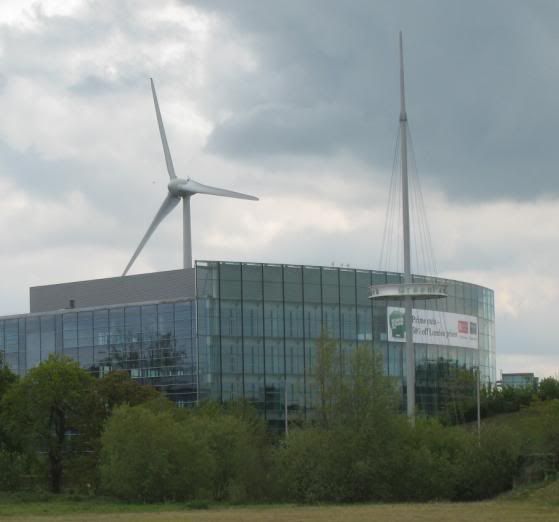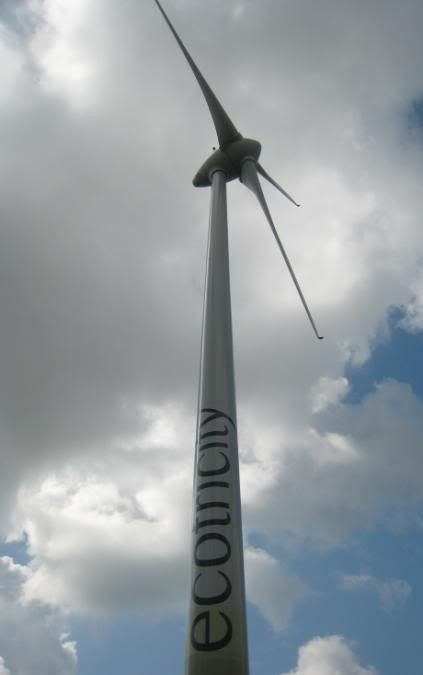Vital statistics
Site address - South Oak Way, Green Park, Reading
Running Since - 18 Nov 2005
Turbines - 1
Hub height - 85m
Rotor diameter - 70m
Capacity - 2MW
Green electricity per year - 3.5 million units
Equivalent homes - 1,063
CO2 savings - 3,018 tonnes

Yesterday I went on a tour of the GreenPark Wind turbine. Around 20,000 schoolchildren a year and many adults go on this tour. They've got a little visitors area with various information boards and a electronic readout of power generation, which is not accurate (we were told). Its probably seen by more people every day than any other windmill, anywhere (its next to the M4. (For some reason Ecotricity call them windmills, not wind turbines).
The hub is 85m above ground level. The blades are 35m long. Its the largest type of wind turbine in the EU , there are 2000 in Germany. It weighs 300 tons. For safety its locked down at 68 wind mph speed. Made in Germany by enercom.
Most of the first generation of turbines were 45m and geared mechanism, they changed gear like a car. Very mechanised. Now they are more more software oriented. Much less noisy. The old turbines had a thump that you could hear above the road noise.
In contrast, the domestic units, such as the plugandsave or airdolphin cost £1500ish each and make £10 a year return, so are not going to make much money. Better to combine with others and get a big one. Better to be over 12 m high. The wind speed is stronger at height, double or more.
In Germany the planning process to build these takes a maximum of 1 year, in the UK in Hayling Island its taken 16 years. Enercon is not offering or supplying wind turbines to offshore projects as Enercon's managing director Aloys Wobben questions the costs and risks of offshore wind farms because the demand for onshore wind turbines where costs and risks are significantly lower can hardly be satisfied!
Common myths about wind turbines:
Reflections distracts cars; light absorbent paint has been used for 14 years now, so no. There is flicker caused by shadows of the moving blades, but in a car you get flicker from moving past trees and buildings, so no added danger there.
Bird strike; consult experts such as the RSPB to site away from migration routes. The RSPB supports wind turbines. A recent US study, Comparison of Reported Effects and Risks to Vertebrate Wildlife – which appears to be the only comparative study of electricity generation to factor in wildlife mortality – concludes that thanks to emissions of sulphur dioxide, nitrogen oxide, carbon dioxide and mercury, coal-fired generation is a far greater killer. But it's also worth mentioning that birds and bats fly into oil platforms and cooling towers, too.

Noise. Anti wind groups like HARM (against proposed Rushey Mead Wind Farm also on the M4) say that wind turbines cause sleep deprivation. A study says this is wrong, its quieter than roads. HARM are protesting a wind farm sited by the M4, so it will be drowned by wind noise. HARM are Nimbys (Not-in-My-Backyarders). They want wind farms to be over a mile from the nearest home, so only in the remotest parts of the country. You can hear the road in my video, not the turbine.
Interesting sites
Wind Energy Planning
RenewableUK
Ecotricity
Green Energy
RES
Sustainable Development Commission
therenewableenergycentre
I haven't checked them, but these are said to be peer reviewed science:
“Infrasound from Wind Turbines – Fact, Fiction or Deception?” by Geoff Leventhall in Vol. 34 No.2 (2006) of the peer-reviewed journal Canadian Acoustics “Electricity generation and health” in the peer-reviewed journal The Lancet . The paper concludes that “Forms of renewable energy generation are still in the early phases of their technological development, but most seem to be associated with few adverse effects on health”
Also - non-peer reviewed but still worth considering
“Wind Turbine Facilities Noise Issues” by Dr. Ramani Ramakrishnan for the Ontario
Ministry of the Environment “Wind Turbine Acoustic Noise”, A White Paper by Dr. Anthony Rodgers at the University of Massachusetts at Amherst.
“Research into Aerodynamic Modulation of Wind Turbine Noise”, University of Salford, UK, July 2007
“Health impact of wind turbines” , prepared by the Municipality of Chatham-Kent Health & Family Services Public Health Unit. Comprehensive review of available literature; Energy, sustainable development and health, World Health Organisation, June 2004.






4 comments:
Surely it is possible to post the costs and returns for this turbine WITH THE SUBSIDY STRIPPED OUT?
Any mechanical installation has a pay-back time (point where profit begins) dependent on build-cost and maintenance, set against yield. The Mail - being the Mail - focused on subsidy to distort underlying fact: is it a viable investment in real terms? Silence from the owners suggests not.
Why focus on renewable subsidy while ignoring fossil fuel and nuclear? There are other things you have said that are worth contradicting , but I don't have the time. A little research perhaps from the links in this post (from 2010) may help.
There is also the costs of not reducing carbon emissions, such as higher insurance costs or rebuilding costs as a result of extreme weather and flooding.
The issues are not simple and modern economic theories are generally short term and fail to include externals.
Other costs to society outside the trade in energy, include higher insurance costs caused by extreme weather. There are many other external costs.
Generally speaking economic theories are not sophisticated enough to deal with the bigger picture.
Indeed some economists and politicians like it like that, because it allows them to compartmentalise costs. Their brains unable to comprehend the harder work to broaden the area of calculations.
If you don't subsidise energy today to establish new technology, so that later it can stand on it's own. Then for hundreds of years later, you would have to subsidise insurance etc or just allow people to drown and be homeless.
Post a Comment